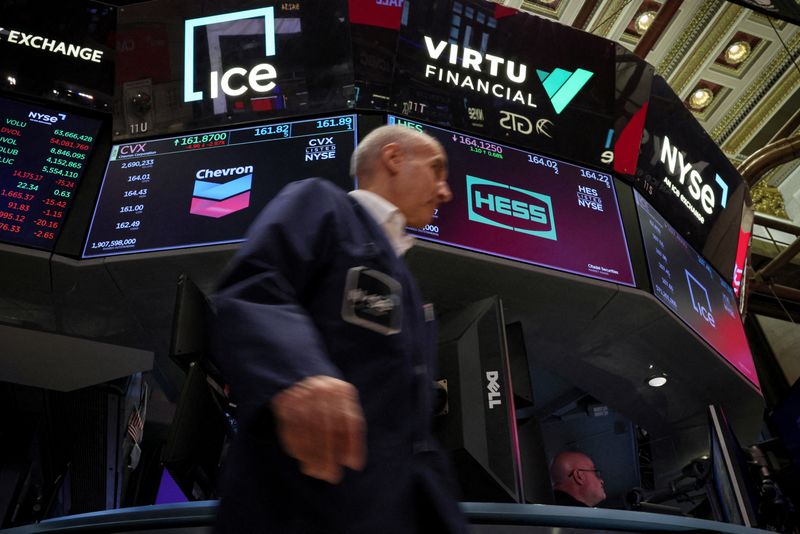By Saqib Iqbal Ahmed
NEW YORK (Reuters) - Volatility-linked investment strategies are joining the nascent sell-off in U.S. stocks and could help accelerate declines if market gyrations keep increasing.
Volatility control funds - systematic investment strategies that typically buy equities when markets are calm and sell when they grow turbulent - hoovered up stocks as the S&P 500 marched to record highs this year.
With the S&P 500 now off more than 4% from those levels and the Cboe Volatility Index near its highest point since October, some of these funds are once again becoming sellers.
Though the S&P 500 is still up about 5% year-to-date, further gyrations could trigger more selling from the funds: analysts at Nomura estimate the strategies could dump some $45 billion worth of stocks if the S&P 500 averages daily moves of 1% over the next two weeks.
"Their positioning is clearly above average,” said Parag Thatte, a strategist at Deutsche Bank. "There is room for them to pull back in terms of exposure."
Nomura's Charlie McElligott estimates that volatility control funds have already started selling, shedding about $16.2 billion in equity exposure over the last week.
While that is small compared with the S&P 500’s $42 trillion market capitalization, the funds’ tendency to follow market momentum can sometimes exaggerate stock moves, market participants said. Other, slower moving strategies could also join in if volatility increases.
The market's recent swings were preceded by a long period of calm in which investors piled in to equities, driven by evidence of strong-yet-stable economic growth and expectations that the Fed would deliver several rate cuts this year. The VIX has not risen over the 20 mark - a level associated with healthy demand for portfolio hedges - for 120 sessions, the longest such streak since 2018.
Stock gyrations have increased in recent weeks as hopes for rate cuts fade in the face of stronger-than-expected inflation. Those worries have been exacerbated as a spreading conflict in the Middle East drives up oil prices, threatening to push inflation higher.
Volatility has picked up in other asset classes as well. The MOVE index, measuring expected volatility in U.S. Treasuries, stands at a three-month high following a steady rise in Treasury yields. The Deutsche Bank FX Volatility Index, a measure of currency market swings, has climbed to a near 10-week high in the face of a rally in the U.S. dollar.
"The volatility increase we're seeing is across asset classes," said Mandy Xu, head of derivatives market intelligence at Cboe Global Markets (NYSE:CBOE). "I think it is the market waking up to potential downside risk."
One reason that selling from volatility-control funds has not kicked in to higher gear so far is that the declines in the S&P 500 have been relatively measured, Barclays strategists wrote.
However, “the funds are quite susceptible to a massive unwinding from the currently high level of equity allocation, particularly if volatility reprices higher in case inflation keeps surprising to the upside, limiting the Fed's ability to cut rates," according to Barclays.
Volatility control funds have a relatively short fuse compared with other computer-driven strategies, making them among the first to react when the market landscape changes.
A more pronounced jump in volatility could also activate slower-reacting funds that use volatility as a trading signal, including commodity trading advisers and risk parity funds, piling more pressure on the market as they ramped up selling.
Nomura’s McElligott said CTAs could sell some $31 billion in equities if the S&P 500 falls another 2% to around the 4,914 level in the weeks ahead.

One catalyst for such moves could be corporate earnings season, which kicked in to gear last week. Investors next week will be bracing for earnings from a slew of technology and growth heavyweights, including Tesla (NASDAQ:TSLA), Meta Platforms (NASDAQ:META), Microsoft (NASDAQ:MSFT) and Google parent Alphabet (NASDAQ:GOOGL). The U.S. will also get a look at another inflation measure on April 26, when the personal consumption expenditures index is released.
"Volatility control has been the larger force to date with regard to systematic deleveraging ... during this choppy pullback," McElligott said. "CTAs join the party in the coming weeks if weakness persists."